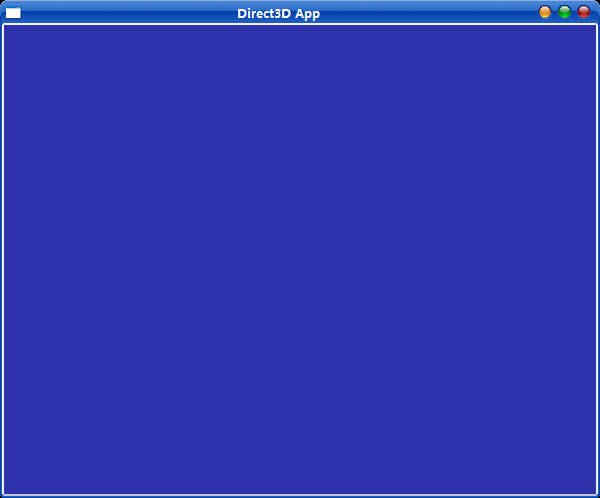-- 发布时间:11/26/2008 8:25:00 AM
--
Direct3D程序基本结构
虽然Direct3D功能非常强大,但是Direct3D程序的基本结构非常简单清晰,它主要有5个步骤:
(1)创建一个Windows窗口。
(2)初始化Direct3D,包括创建Direct3D对象、Direct3D设备对象以及要渲染的图形对象。
(3)消息循环。
(4)渲染图形。
(5)清除在初始化时创建的所有COM对象,退出程序。
其中消息循环和渲染图形不断进行,如果程序有消息需要处理,则先处理消息,然后再渲染图形;如果没有消息处理,则一直不停地渲染图形,直到退出Direct3D程序。
最简单的Direct3D程序
#include <d3d9.h>
#define CLASS_NAME "GameApp"
#define release_com(p) { if(p) { (p)->Release(); (p) = NULL; } }
IDirect3D9* g_d3d;
IDirect3DDevice9* g_device;
bool init_d3d(HWND hwnd)
{
g_d3d = Direct3DCreate9(D3D_SDK_VERSION);
if(g_d3d == NULL)
return false;
D3DPRESENT_PARAMETERS d3dpp;
ZeroMemory(&d3dpp, sizeof(d3dpp));
d3dpp.Windowed = TRUE;
d3dpp.SwapEffect = D3DSWAPEFFECT_DISCARD;
d3dpp.BackBufferFormat = D3DFMT_UNKNOWN;
if(FAILED(g_d3d->CreateDevice(D3DADAPTER_DEFAULT, D3DDEVTYPE_HAL, hwnd, D3DCREATE_SOFTWARE_VERTEXPROCESSING,
&d3dpp, &g_device)))
{
return false;
}
return true;
}
void cleanup()
{
release_com(g_device);
release_com(g_d3d);
}
void render()
{
g_device->Clear(0, NULL, D3DCLEAR_TARGET, D3DCOLOR_XRGB(45, 50, 170), 1.0f, 0);
g_device->BeginScene();
// render game scene here
g_device->EndScene();
g_device->Present(NULL, NULL, NULL, NULL);
}
LRESULT WINAPI WinProc(HWND hwnd, UINT msg, WPARAM wParam, LPARAM lParam)
{
switch(msg)
{
case WM_KEYDOWN:
if(wParam == VK_ESCAPE)
DestroyWindow(hwnd);
break;
case WM_DESTROY:
PostQuitMessage(0);
return 0;
}
return DefWindowProc(hwnd, msg, wParam, lParam);
}
int WINAPI WinMain(HINSTANCE inst, HINSTANCE, LPSTR, INT)
{
WNDCLASSEX wc;
wc.cbSize = sizeof(WNDCLASSEX);
wc.style = CS_CLASSDC;
wc.lpfnWndProc = WinProc;
wc.cbClsExtra = 0;
wc.cbWndExtra = 0;
wc.hInstance = inst;
wc.hIcon = NULL;
wc.hCursor = NULL;
wc.hbrBackground = NULL;
wc.lpszMenuName = NULL;
wc.lpszClassName = CLASS_NAME;
wc.hIconSm = NULL;
if(! RegisterClassEx(&wc))
return -1;
HWND hwnd = CreateWindow(CLASS_NAME, "Direct3D App", WS_OVERLAPPEDWINDOW, 200, 100, 600, 500,
NULL, NULL, wc.hInstance, NULL);
if(hwnd == NULL)
return -1;
if(init_d3d(hwnd))
{
ShowWindow(hwnd, SW_SHOWDEFAULT);
UpdateWindow(hwnd);
MSG msg;
ZeroMemory(&msg, sizeof(msg));
while(msg.message != WM_QUIT)
{
if(PeekMessage(&msg, NULL, 0, 0, PM_REMOVE))
{
TranslateMessage(&msg);
DispatchMessage(&msg);
}
else
{
render();
}
}
}
cleanup();
UnregisterClass(CLASS_NAME, wc.hInstance);
return 0;
}
运行截图:
